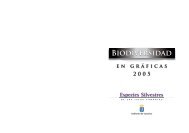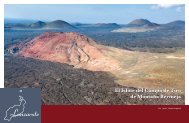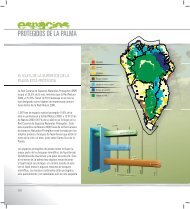Adapting the IUCN Red List criteria for invertebrates - Dr. José L ...
Adapting the IUCN Red List criteria for invertebrates - Dr. José L ...
Adapting the IUCN Red List criteria for invertebrates - Dr. José L ...
Create successful ePaper yourself
Turn your PDF publications into a flip-book with our unique Google optimized e-Paper software.
locations as defined by <strong>the</strong> <strong>IUCN</strong>. These kinds of techniques are<br />
only now beginning to be widely used <strong>for</strong> conservation purposes,<br />
with only a few cases pre-dating <strong>the</strong> current <strong>IUCN</strong> <strong>criteria</strong>. The<br />
application of ecological modelling should be considered in <strong>the</strong> future,<br />
particularly <strong>for</strong> invertebrate species or o<strong>the</strong>r taxa <strong>for</strong> which<br />
in<strong>for</strong>mation will probably never be complete. The best way to<br />
use distribution modelling to conduct <strong>Red</strong> <strong>List</strong> classifications is<br />
an area that deserves fur<strong>the</strong>r study.<br />
2.3. Small population size and decline – Criterion C<br />
This criterion is based on <strong>the</strong> number of individuals in a species<br />
and <strong>the</strong> possibility of <strong>the</strong>ir decline or extreme population fluctuations<br />
(Table 1). Even when it is possible to estimate <strong>the</strong> number of<br />
individuals by exhaustively conducting standardized sampling in a<br />
limited set of small areas and extrapolating (see Stroot and Depiereux,<br />
1989), <strong>the</strong> current threshold values are inadequate. Mace<br />
et al. (2008) justify <strong>the</strong> use of <strong>the</strong> current population size thresholds<br />
because ‘‘demographic stochasticity is unlikely to be important<br />
<strong>for</strong> any population that has more than about 100<br />
individuals’’. However, most invertebrate species would probably<br />
be condemned to extinction by demographic stochasticity if only<br />
100 individuals were living, given <strong>the</strong> relatively low probability<br />
that each individual finds a partner, mates, lays eggs and, in many<br />
cases, raises <strong>the</strong> juveniles until <strong>the</strong>y are independent, <strong>the</strong>re<strong>for</strong>e<br />
ensuring <strong>the</strong> survival of <strong>the</strong> next generation. The current <strong>IUCN</strong> population<br />
thresholds simply have no reasonable application <strong>for</strong> most<br />
invertebrate species and <strong>the</strong>re<strong>for</strong>e most extant global species richness.<br />
This may lead to an underestimation of extinction risk.<br />
The thresholds of abundance should increase to numbers that<br />
reflect realistic values <strong>for</strong> <strong>invertebrates</strong>, possibly a few orders of<br />
magnitude higher than <strong>the</strong> current ones, <strong>the</strong>reby increasing <strong>the</strong>ir<br />
adequacy. Given <strong>the</strong> large variability in body size of <strong>invertebrates</strong>,<br />
from dozens of microns (Cycliophorans) to more than a dozen<br />
metres (squid), <strong>the</strong> thresholds in abundance could be variable<br />
and likely even inversely correlated with body size.<br />
2.4. Very small or restricted population – Criterion D<br />
This criterion is based on <strong>the</strong> number of individuals of a species<br />
or a species found in a restricted range or number of locations (Table<br />
1). As with <strong>the</strong> previous criterion, even when it is possible to<br />
estimate <strong>the</strong> number of individuals of a species, <strong>the</strong> current threshold<br />
values are clearly inadequate. Likewise, <strong>the</strong>re<strong>for</strong>e, this criterion<br />
can lead to an underestimation of extinction risk <strong>for</strong> <strong>invertebrates</strong>.<br />
As in <strong>the</strong> previous criterion, <strong>the</strong> thresholds of abundance should<br />
be increased to adequate numbers. Additionally, given that estimating<br />
absolute abundance data is very difficult, we suggest that<br />
<strong>the</strong> AOO could be used as a sufficient criterion <strong>for</strong> more categories<br />
than Vulnerable (Table 1). Many invertebrate species are confined<br />
to extremely small areas (even less than 1 ha), and a single event<br />
could drive <strong>the</strong>m to extinction even if <strong>the</strong>y are not currently in decline.<br />
Such events, if considered as plausible near-future threats<br />
(e.g., pollution spills, nearby active volcanoes) could be used to justify<br />
listing an extremely restricted species as CR or EN. In this way,<br />
<strong>the</strong> applicability of this criterion would increase by allowing <strong>the</strong><br />
use of AOO to classify a species into any category.<br />
2.5. Quantitative analysis of extinction risk – Criterion E<br />
This criterion is based on a quantitative analysis of extinction<br />
risk (Table 1), usually population viability analysis (PVA). This<br />
technique has seldom been applied to <strong>invertebrates</strong> or o<strong>the</strong>r<br />
small-bodied organisms (Schultz and Hammond, 2003; Bergman<br />
and Kindvall, 2004). In fact, as recognized by <strong>the</strong> <strong>IUCN</strong>, this crite-<br />
P. Cardoso et al. / Biological Conservation 144 (2011) 2432–2440 2435<br />
rion requires <strong>the</strong> most exhaustive data and is difficult to apply<br />
even <strong>for</strong> many vertebrate taxa.<br />
However, PVA is not <strong>the</strong> only method <strong>for</strong> <strong>the</strong> quantitative analysis<br />
of extinction risk, and it should be possible to analyse extinction<br />
risk in situations of restricted habitat and predictable habitat<br />
disappearance (including co-extinction, see below). Moreover, decreases<br />
in habitat quality can also have major impacts on population<br />
persistence (Schultz and Hammond, 2003). Because <strong>the</strong>re is an<br />
extinction debt between <strong>the</strong> time of habitat disappearance and<br />
species extinction (Tilman et al., 1994; Triantis et al., 2010) <strong>the</strong>ir<br />
correlation is not straight<strong>for</strong>ward. This criterion should <strong>the</strong>re<strong>for</strong>e<br />
explicitly incorporate <strong>the</strong> probability of habitat disappearance <strong>for</strong><br />
species with restricted habitat types. In this way, <strong>the</strong> applicability<br />
of this criterion <strong>for</strong> invertebrate species would increase.<br />
Projections of global warming and its consequences on species<br />
usually consider 50–100 years into <strong>the</strong> future. Given <strong>the</strong> oftenshort<br />
generation time of <strong>invertebrates</strong>, using such projections<br />
may prove especially useful <strong>for</strong> classifying species into <strong>the</strong> Vulnerable<br />
category (Table 1). It is, however, extremely difficult to provide<br />
exact probabilities of extinction in a given time frame as<br />
required by <strong>the</strong> current criterion (Akçakaya et al., 2006). The quality<br />
of data is especially critical <strong>for</strong> projections using <strong>the</strong> many different<br />
long-term climate change scenarios that are available, and<br />
extinction debt must also be taken into account. Determining <strong>the</strong><br />
most appropriate way to incorporate future projections of AOO<br />
and <strong>the</strong> respective change from <strong>the</strong> present AOO, perhaps by using<br />
ecological modelling (e.g., Araújo et al., 2005), is an additional area<br />
that should be considered <strong>for</strong> future studies.<br />
2.6. Co-extinction<br />
Invertebrates are prone to extinction factors that rarely affect<br />
vertebrates (Dunn, 2005). Many species are dependent on a single<br />
host, prey or o<strong>the</strong>r species that are, <strong>for</strong> various reasons, essential to<br />
<strong>the</strong>ir survival. This includes monophagous predators and herbivores<br />
and single-species parasites or parasitoids. In fact, it has already<br />
been suggested that co-extinction may be <strong>the</strong> most<br />
common <strong>for</strong>m of extinction (Koh et al., 2004; Dunn et al., 2009).<br />
Such dependency may occur at any life stage (eggs, larvae, juveniles<br />
or adults) or sex (often males and females do not overlap in<br />
<strong>the</strong>ir use of resources).<br />
If a host or prey species is listed in any category, <strong>the</strong> dependent<br />
species should be immediately considered in same category without<br />
fur<strong>the</strong>r justification. Although this can be justified with <strong>the</strong><br />
current <strong>criteria</strong>, it is usually only through indirect evidence of <strong>the</strong><br />
inferred decline of <strong>the</strong> population.<br />
3. Case studies<br />
3.1. Datasets<br />
To test <strong>the</strong> application of <strong>the</strong> <strong>criteria</strong> to various invertebrate<br />
taxa in different regions, we have compiled in<strong>for</strong>mation <strong>for</strong> two<br />
comprehensive datasets, each with 24 species, <strong>for</strong> a total of 48 species<br />
evaluated (Appendix 1). We restricted our analyses to species<br />
endemic to each region to per<strong>for</strong>m global evaluations. The given<br />
datasets were chosen because data were relatively comprehensive,<br />
publicly available and familiar to <strong>the</strong> authors.<br />
The first dataset was composed of arthropod species endemic to<br />
<strong>the</strong> Azores archipelago. The arthropod fauna of <strong>the</strong> Azores is particularly<br />
well known because standardized sampling has been per<strong>for</strong>med<br />
over <strong>the</strong> last 10 years in all of <strong>the</strong> remaining natural<br />
<strong>for</strong>ests on <strong>the</strong> islands (Borges et al., 2005; Gaspar et al., 2008, in<br />
press). In addition, work has recently been per<strong>for</strong>med using <strong>the</strong><br />
same sampling protocol in o<strong>the</strong>r types of habitats, including heav-





